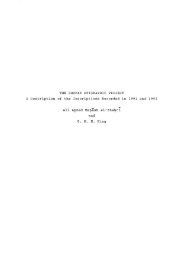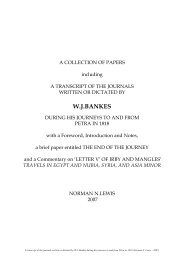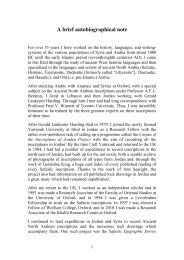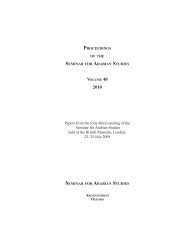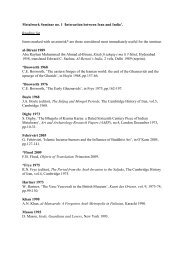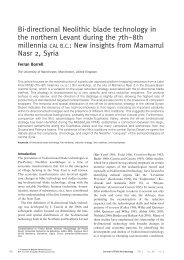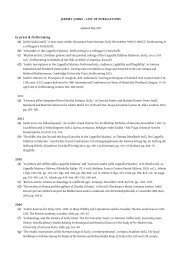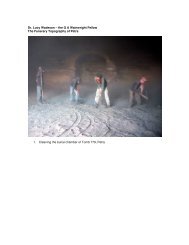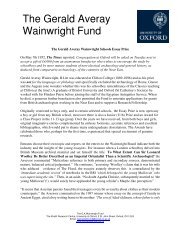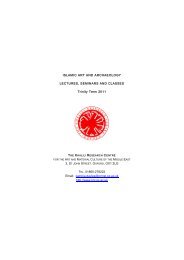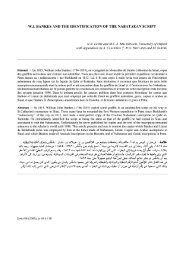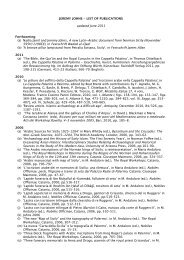Reflections on the linguistic map of pre-Islamic Arabia - Khalili ...
Reflections on the linguistic map of pre-Islamic Arabia - Khalili ...
Reflections on the linguistic map of pre-Islamic Arabia - Khalili ...
You also want an ePaper? Increase the reach of your titles
YUMPU automatically turns print PDFs into web optimized ePapers that Google loves.
Thus, <strong>the</strong>re is at <strong>pre</strong>sent a very clear c<strong>on</strong>trast<br />
between eastern <strong>Arabia</strong>, where<br />
writing seems hardly to have taken root,<br />
and <strong>the</strong> western two-thirds <strong>of</strong> <strong>the</strong> Peninsula<br />
where it seems to have been endemic.<br />
This said, however, <strong>the</strong>re are also clear distincti<strong>on</strong>s<br />
between <strong>the</strong> northwest and <strong>the</strong><br />
southwest in languages, scripts, <strong>the</strong> types<br />
<strong>of</strong> document available and relati<strong>on</strong>s with<br />
o<strong>the</strong>r societies. In what follows, I shall be<br />
c<strong>on</strong>centrating <strong>on</strong> what we know <strong>of</strong> <strong>the</strong><br />
<strong>linguistic</strong> situati<strong>on</strong> in north and central <strong>Arabia</strong><br />
in <strong>the</strong> first millennia BC and AD. I<br />
shall not deal with <strong>the</strong> languages <strong>of</strong> ancient<br />
South <strong>Arabia</strong>, except when <strong>the</strong>y impinge<br />
<strong>on</strong> those <strong>of</strong> <strong>the</strong> north (84).<br />
Ancient North <strong>Arabia</strong>n<br />
The hn-dialects<br />
In northwestern <strong>Arabia</strong> a multiplicity <strong>of</strong><br />
dialects developed within <strong>the</strong> group I have<br />
called Ancient North <strong>Arabia</strong>n, which uses<br />
h- as <strong>the</strong> definite article. The earliest occurrence<br />
<strong>of</strong> this article is in <strong>the</strong> name <strong>of</strong> <strong>the</strong><br />
goddess hn- $ lt in <strong>the</strong> Aramaic dedicati<strong>on</strong>s<br />
<strong>on</strong> silver bowls found at her shrine at Tell<br />
al-Mashūtw a, in <strong>the</strong> Nile delta. These have<br />
been dated to <strong>the</strong> late fifth century BC (85).<br />
One <strong>of</strong> <strong>the</strong> dedicators was Qaynū bar<br />
Gesˇem, king <strong>of</strong> Qēdār, and it has recently<br />
been suggested that this is evidence that<br />
this tribe could have spoken a h-/hn-dialect<br />
(86). However, this is to stretch <strong>the</strong> evidence<br />
too far. The o<strong>the</strong>r dedicati<strong>on</strong>s found<br />
at <strong>the</strong> shrine are also to hn- $ lt. Of <strong>the</strong> two<br />
o<strong>the</strong>rs which name <strong>the</strong> dedicator, <strong>on</strong>e is<br />
made by a man with an Egyptian name<br />
and a North <strong>Arabia</strong>n patr<strong>on</strong>ym (87), while<br />
in <strong>the</strong> o<strong>the</strong>r both names are Semiticized<br />
Egyptian (88). It seems clear, <strong>the</strong>refore, that<br />
<strong>the</strong> goddess <strong>of</strong> this shrine was worshipped<br />
as hn- $ lt, regardless <strong>of</strong> how this epi<strong>the</strong>t<br />
would be realized in <strong>the</strong> languages <strong>of</strong> individual<br />
pilgrims, or <strong>the</strong> Aramaic <strong>of</strong> <strong>the</strong><br />
dedicati<strong>on</strong>s. This epi<strong>the</strong>t cannot <strong>the</strong>refore<br />
THE LINGUISTIC MAP OF PRE-ISLAMIC ARABIA<br />
be used as evidence for <strong>the</strong> language<br />
spoken by <strong>the</strong> tribe <strong>of</strong> Qēdār or any o<strong>the</strong>r<br />
<strong>of</strong> <strong>the</strong> dedicants.<br />
Similarly, this example should warn us<br />
that <strong>the</strong> epi<strong>the</strong>t $ Alilát menti<strong>on</strong>ed by Herodotus<br />
(89) is not necessarily evidence for<br />
<strong>the</strong> dialect <strong>of</strong> his Arab informants (who<br />
were probably living in eastern Egypt or<br />
Sinai). In ancient Near-Eastern religi<strong>on</strong>s<br />
epi<strong>the</strong>ts rapidly became names and, <strong>on</strong>ce<br />
this had happened, <strong>the</strong> form <strong>of</strong> <strong>the</strong> name<br />
was fixed. All we can say is that in eastern<br />
Egypt in <strong>the</strong> fifth century BC both <strong>the</strong> hand<br />
<strong>the</strong> $ l-dialects were re<strong>pre</strong>sented in <strong>the</strong><br />
epi<strong>the</strong>t ‘<strong>the</strong> goddess’ (90), but with no certainty<br />
as to who was speaking <strong>the</strong>se dialects<br />
at <strong>the</strong> time, or where <strong>the</strong>y originated.<br />
Dadanitic<br />
The <strong>on</strong>e dialect <strong>of</strong> Ancient North <strong>Arabia</strong>n in<br />
which it is certain that hn- was used was Dadanitic.<br />
The normal Dadanitic article is hbut<br />
before / $ / (91) and / c / (92) it is hn-. It<br />
has been suggested that hn- is a survival <strong>of</strong><br />
<strong>the</strong> original article in all members <strong>of</strong> this<br />
group, but that in <strong>the</strong> o<strong>the</strong>r dialects it was reduced<br />
to h- (93). It is impossible to prove or<br />
disprove this <strong>the</strong>ory, but if this were so, <strong>on</strong>e<br />
would expect <strong>the</strong> odd irregularity <strong>of</strong> usage<br />
in Dadanitic and sporadic survivals in o<strong>the</strong>r<br />
dialects. In fact, however, <strong>the</strong>re is <strong>on</strong>ly <strong>on</strong>e<br />
possible instance in Dadanitic <strong>of</strong> hn- before<br />
a ph<strong>on</strong>eme which is not a pharyngal or a<br />
glottal (94), and no certain examples (except<br />
in names) in <strong>the</strong> o<strong>the</strong>r dialects. So this feature<br />
could just as well, or perhaps more<br />
likely, be a euph<strong>on</strong>ic development within<br />
Dadanitic, as a survival from an earlier<br />
period.<br />
A Safaitic inscripti<strong>on</strong>, by an author who<br />
gives his nisba as hn-hw wly (95), provides an<br />
interesting footnote to this discussi<strong>on</strong>. It is<br />
clear from many o<strong>the</strong>r Safaitic texts that <strong>the</strong><br />
Hw wlt came from outside <strong>the</strong> normal migrati<strong>on</strong><br />
areas <strong>of</strong> <strong>the</strong> tribes east <strong>of</strong> <strong>the</strong> Hw awrān<br />
whose members wrote <strong>the</strong>se graffiti,<br />
41



